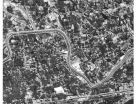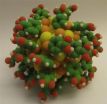The research is bringing together the unusual combination of latest computer modelling techniques developed at the University of Leeds, and archaeology and anthropology expertise at the University of Bristol.
With Engineering and Physical Sciences Research Council (EPSRC) funding, spines from up to 40 skeletons housed in museums and university anatomy collections are being analysed in the research.
The data generated, on different spine conditions and on how spines vary in size and shape, is playing a key role in the development of innovative computer models. This will enable the potential impact of new treatments and implant materials (such as keyhole spinal surgery and artificial disc replacements) to be evaluated before they are used on patients.
Ultimately, it will also be possible to use the models to pinpoint the type of treatment best suited to an individual patient.
Minister for Universities and Science David Willetts said:
"Back pain is an extremely common condition, but everyone has a slightly different spine so developing new treatments can be a real challenge. This investment could significantly improve quality of life for millions of people around the world, so it's fantastic that the research is being carried out in the UK. It's also truly fascinating that old bones and very new technology can come together to deliver benefits for patients."
This is the first software of its kind designed for the treatment of back conditions. The research will also speed up the process of clinical trials for new treatments, which currently can take up to ten years.
The data provided by the old bones will be used to supplement similar data collected from bodies donated to science, which are limited in number and mainly come from older age groups.
"The idea is that a company will be able to come in with a design for a new product and we will simulate how it would work on different spines. The good thing about computer models is that we can use them over and over again, so we can test lots of different products on the same model", says Dr Ruth Wilcox, from the University of Leeds, who is leading the project. "If we were doing this in a laboratory we would need many new donated spines each time we wanted to test a treatment out".
This computer modelling breakthrough is possible thanks to recent advances in micro-CT (computed tomography) scanning, and to new techniques developed at the University of Leeds enabling data from micro-CT scans to be transformed into sophisticated computer models. Computed tomography (CT) scans use X-rays to build up 3-dimensional images from multiple cross-sectional pictures of body organs or tissues.
"The wider the pool of spinal data at our disposal, the more effective the computer models will be in terms of demonstrating the impact of treatments on different back conditions and back types," says Dr Kate Robson Brown from the University of Bristol's Archaeology and Anthropology Department. "The computer modelling software should be available for testing newly developed products and treatments in the next few years and along the way this cutting-edge research could even provide new insight into how our ancestors evolved!"
INFORMATION:
You can find out more about the research from the team involved in an audio slide show on the EPSRC YouTube channel. (NB the full link address is http://www.youtube.com/user/EPSRCvideo?feature=mhum)
Notes for Editors
The research community and orthopaedic product manufacturers have only recently started to give spines the same sort of attention that they have traditionally given to hips and knees. This is mainly because getting spinal treatment wrong has much more immediate serious implications for the patient and may even result in legal action against product manufacturers or medical staff. The new computer models will therefore provide the knowledge and confidence needed to develop and apply new types of treatment which can be tested out first by the computer modelling process.
Moreover, once a range of new back-pain treatments have been developed by, for example, product manufacturers, it will also be possible to scan a patient's back and then use the computer models to identify the optimum treatment option in that particular case.
The project team will carry out a micro-CT scan on vertebrae in each of the spines they analyse, producing highly detailed 3-dimensional images of the vertebrae. The bank of images generated will then be used by the computer models to 'virtually' test the effectiveness of a variety of possible back-pain treatment options. Those showing clear potential can then progress to the next stage of development.
Engineering, biology, chemistry and computer science will all make a vital contribution to this multidisciplinary project. In addition, close involvement of orthopaedic product manufacturing companies is being sought.
The 5-year project 'Engineering Solutions to Back Pain: An Interdisciplinary Approach' began last year and is due to run until 2013. It will receive EPSRC funding of nearly £1.1 million.
More effective treatment of back pain would have enormous benefits. Apart from a considerable improvement in the quality of life enjoyed by people suffering from the condition, it would also help the economy by reducing time taken off work. Moreover, it could cut the burden on healthcare resources caused by repeated, ongoing visits to GPs and hospital consultants, for example.
The Engineering and Physical Sciences Research Council (EPSRC) is the UK's main agency for funding research in engineering and the physical sciences. The EPSRC invests around £850 million a year in research and postgraduate training, to help the nation handle the next generation of technological change. The areas covered range from information technology to structural engineering, and mathematics to materials science. This research forms the basis for future economic development in the UK and improvements for everyone's health, lifestyle and culture. EPSRC also actively promotes public awareness of science and engineering. EPSRC works alongside other Research Councils with responsibility for other areas of research. The Research Councils work collectively on issues of common concern via Research Councils UK. Website address for more information on EPSRC: www.epsrc.ac.uk/
The University of Bristol is globally distinguished and one of the very best universities in the UK. It is a thriving international community dedicated to learning, discovery and enterprise, a world leader in research and a member of the Worldwide Universities Network and of the Russell Group of UK universities. www.bris.ac.uk/
The Faculty of Engineering at the University of Leeds is amongst the top 10 in the UK for research, according to 2008 Research Assessment Exercise (RAE), with 75% of its activity rated as 'internationally excellent' or 'world leading'. The University of Leeds is one of the largest higher education institutions in the UK and a member of the Russell Group of research-intensive universities. The University's vision is to secure a place among the world's top 50 by 2015. www.leeds.ac.uk/
For more information, contact:
Dr Ruth Wilcox, Institute of Medical and Biological Engineering, University of Leeds, tel: 0113 343 7980, e-mail: r.k.wilcox@leeds.ac.uk
Dr Kate Robson Brown, Department of Archaeology and Anthropology, University of Bristol, tel: 0117 954 6081, e-mail: kate.robson-brown@bristol.ac.uk
Images are available from the EPSRC Press Office. Contact:
EPSRC Press Office on 01793 444404, E-mail: pressoffice@epsrc.ac.uk
Image and caption information:
Ruth.jpg: Dr Ruth Wilcox
Kateinlab.jpg: Dr Kate Robson Brown
Kateandruth.jpg:Dr Kate Robson Brown and Dr Ruth Wilcox
Fullspine.jpg and Spinesection and spinesection2.jpgs: some of the bones being used in the research are hundreds of years old
Model1(TIF image), model2.jpg: The computerised tomography (CT) scans lead to detailed 3-dimensional computer models of vertebra.
END

